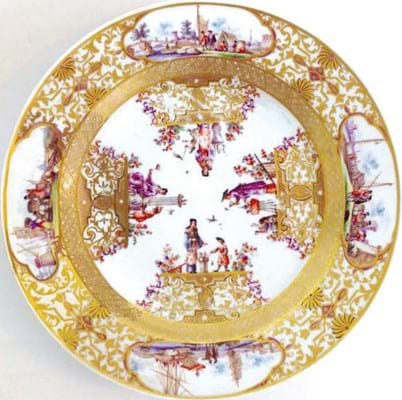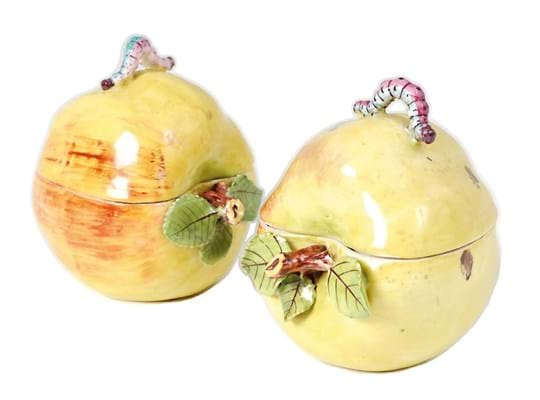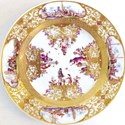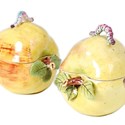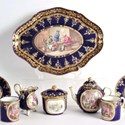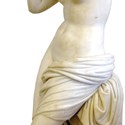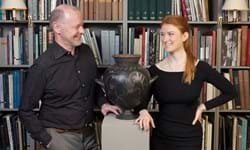Their last consignment to the Bury St Edmunds saleroom had been back in March 1999 – a pair of 1781 Sèvres swan-handled vases sold for £500,000, at the time a record for any work of art sold at a UK auction outside London (ATG No 1383).
The recent entry was two 4in (10cm) tall boxes shaped as russet apples with caterpillar knops. Both dating from c.1755, box one, numbered 48, had the red anchor mark to both base and lid, the other, numbered 51, only to the base.
A minor frit to a leaf on one and slight scratching and tiny chip to the glaze on the cover of the other were the only injuries sustained across their long life.
“Condition was everything,” said auctioneer Edward Crichton. He pitched each box at £6000-9000 and saw his even higher private hopes justified when each went to the same London specialist at £14,000.
Service with a style
The Sèvres tête-à-tête service consigned by a local vendor to Hannam’s (20% buyer’s premium) at Selborne on June 7 was a 19th century product in the rococo taste.
It lacked the scholarly appeal of 18th century rarities but had a wonderfully decorative, high-quality value, and was attractively estimated at £3000-5000. Both the 13in (34cm) tray and the other elements featured jewelled decoration and panels variously painted with figures in a lowly tavern and sprays of flowers and garden tools.
“There was some tiny jewel loss and some wear to the gilt but the condition was good,” said auctioneer Harry Hannam.
Highly decorative Western work such as this does have some appeal in the Far East. It was a Hong Kong buyer who took it at £17,000.
Christian worship
The first European factory to discover the secret of porcelain was, of course, Meissen. Included in the factory’s romantic, and sometimes dark, history is the story of the artist Christian Friedrich Herold (1700- 79) who worked there for more than 50 years under the tutelage – and occasional ill treatment – of his influential cousin Johann Gregor Herold (1696-1775).
A rare work by Christian appeared at Catherine Southon’s (17.25% buyer’s premium) sale at Selsdon on June 7. Dated c.1725, the 9½in (24cm) plate was decorated with four vignettes of maritime scenes to the rim, and four sections depicting Chinese figures, birds and flowers to the centre.
It was catalogued as attributed to Christian Friedrich Herold but a number of experts at the view were confident it was by his hand. Again, condition was key.
“It appeared to have been dropped at one point and repaired,” said Southon, whose catalogue notes also noted a hairline crack to the rim and wear to the gilding on a painted front and cautioned ‘inspection suggested’. Against interest from Germany and the UK trade, it sold to a collector at £3500 against an estimate of £200- 300. “In perfect condition we would have been looking at £15,000,” added Southon.
Scottish sculptor
Meanwhile, among other outstanding lots at Hannam’s 2150-lot, three-day sale was a 3ft 11in (1.19m) tall 19th century marble nude by Scottish neoclassical sculptor Lawrence MacDonald (1799-1878). A founder of the British Academy of Arts in Rome, he worked in Italy from the 1830s.
Estimated at £2000-3000 – the sort of price attained by the artist’s less commercial portrait work – this fully signed idealist female nude sold at £12,750. A larger group derived from the celebrated Tauride Venus of Greek antiquity sold for £52,000 at Sotheby’s in 2015.
Sold at Selborne for £15,500 was a pair of Meiji bronze vases and stands in the manner of Otake Norikuno.
Rare and large, the 18½in (47cm) tall vases were decorated with carp and gold inlay to the twin-handles and doubled the top estimate, selling to the UK provincial trade.
Encouraging furniture results
Back in Bury St Edmunds, two of the better pieces of English furniture brought encouraging results at the LSK sale.
One was a pair of 19th century giltwood pier glasses estimated at £1000-1500. Unusually tall at 8ft 2in (2.48m), the glasses had thin egg-and-dart-moulded frames but their primary appeal, auctioneer Crichton believed, lay in the original rectangular plates. The pair went to the London trade at £6500.
The other was a Regency oak breakfast table with 5ft 11in (1.80m) diameter crossbanded tilt-top.
It had splits to the top which suffered some warping and half the moulding round the edge had gone. The table was originally destined for a general sale, but Crichton said: “I just thought there was something to it so I put it into this sale, although keeping the £200-400 estimate.
“When the bidding reached £2000, the penny dropped. It was certainly manner of Bullock.”
The dealer who bid the winning £6800 will have to lay out more cash on restoration but it could prove a shrewd investment.


